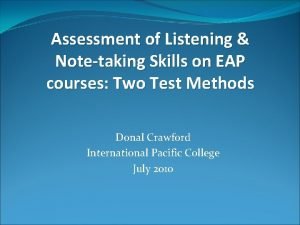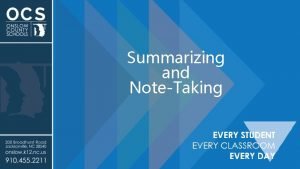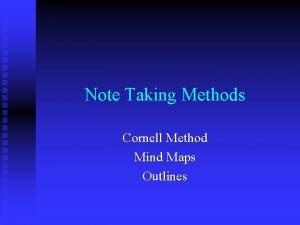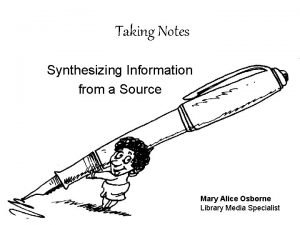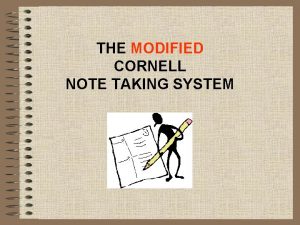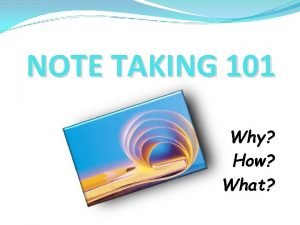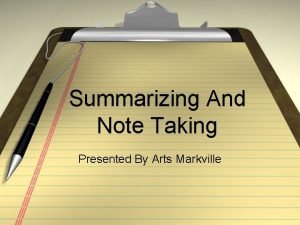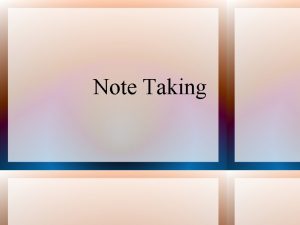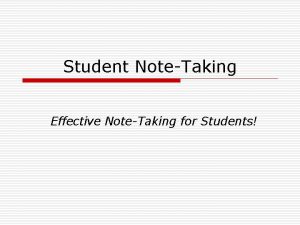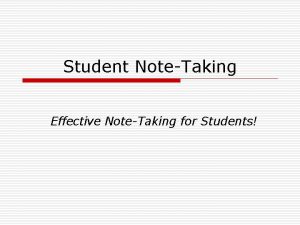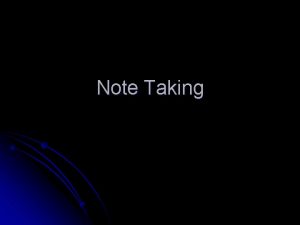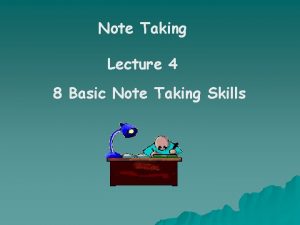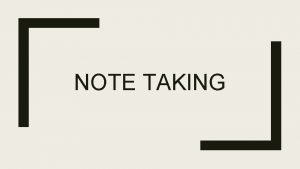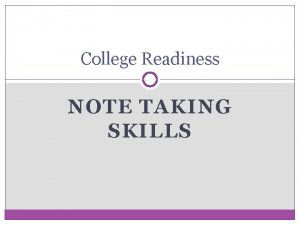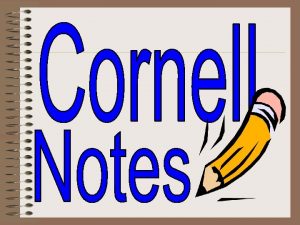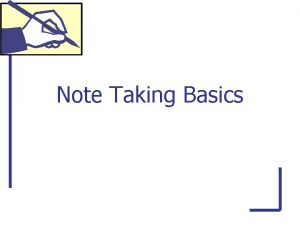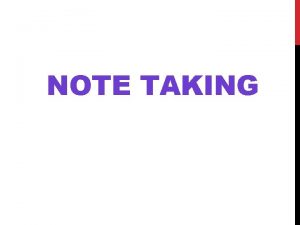NOTE TAKING PREREQUISITES OF NOTETAKING Recognizing the main

















- Slides: 17

NOTE TAKING

PREREQUISITES OF NOTETAKING • Recognizing the main ideas • Identifying what information is relevant • Having a system of note taking • Reducing the information • Summarize in your own words • Record the source of information

READING AND NOTE TAKING 1) Be selective and systematic • -purpose of reading • -skim • -highlight • Note taking system 2) Identify the purpose and function of text • Read the title/abstract/preface • Read the introduction • Read topic headings • Read graphic content

READING AND NOTE TAKING 3) Identify how information is organized • Past ideas to present • Steps or stages of a process or event • Most important to least important • Well known to least known • Simple to complex • Problems to solutions • Causes to results

READING AND NOTE TAKING 4) Include your thoughts • Your ideas, reflection • How to use information in assignment

SAMPLES

SAMPLES

SAMPLES

SAMPLES

LISTENING AND NOTE TAKING 1) Before lecture • Have a clear purpose • Have a system for recording • Revise the previous lecture • Pre read the topic • Check the pronunciation of any new word or discipline specific language in the pre reading • Prepare for your note taking system

LISTENING AND NOTE TAKING 2) During the Lecture • Be on time and sit near the front • Distinguish between main ideas, elaboration, examples, repetition, restatements and new ideas • Listen for structural cues (sign posts/transition words, intro, body and conclusion) • Listen for non verbal cues (facial expressions, hand body signals) • Listen for phonological cues (in volume, speed, emotion)

LISTENING AND NOTE TAKING 3) After the lecture • Revise lecture notes • Fill in missing ideas • Review • Write a short summary of the lecture • Attach any handouts to your lecture notes

USE SYMBOLS AND ABBREVIATIONS • Symbols and abbreviations • Be consistent in using them SYMBOLS = + > < _ →↑↓♂ Abbreviations c. f. (confer)=compare i. e. (id est)= for example NB (nota benne)=note well No (numero)= number etc (et cetera)= and so on

USE SYMBOLS AND ABBREVIATIONS DISCIPLINE SPECIFIC Au for gold Mg for Magnesium A (alpha) B (beta) PERSONAL ABBREVIATIONS Diff= different Gov=government NEC= necessary

USE CONCEPTS AND MAPS


5 R’S OF NOTE TAKING • Record • Reduce • Recite • Reflect • review
 Prerequisites of note-taking
Prerequisites of note-taking Listening and notetaking skills
Listening and notetaking skills Difference between note making and note taking
Difference between note making and note taking Whats signal words
Whats signal words Difference between note making and note taking
Difference between note making and note taking Note taking and note making
Note taking and note making Summarizing and note taking strategies
Summarizing and note taking strategies Mind mapping note taking method
Mind mapping note taking method Abc lou note taking
Abc lou note taking Animal behavior worksheet
Animal behavior worksheet Note taking legend
Note taking legend Cornell note taking strategy
Cornell note taking strategy Effective note-taking methods
Effective note-taking methods What are the 5 r's of note taking
What are the 5 r's of note taking Note taking 101-part 2
Note taking 101-part 2 Tnetn
Tnetn Summarizing and note taking strategies
Summarizing and note taking strategies Note taking 101
Note taking 101

